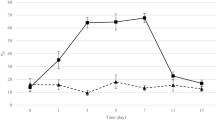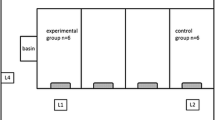Abstract
The influence of pefloxacin, 400 mg twice daily for ten days, on microbial colonization resistance was investigated in six healthy volunteers. In three volunteers impairment of colonization resistance was indicated by a significant increase in the faecal concentration of yeasts. In two of them, impairment of colonization resistance was confirmed by facilitation of colonization by a challenge strain ofKlebsiella pneumoniae in the early post-treatment period. It is concluded that pefloxacin impairs colonization resistance in some volunteers. However, during pefloxacin therapy, overgrowth by aerobic bacteria is prevented by the very high antimicrobial concentration in faeces, and after therapy it is prevented by rapid restoration of colonization resistance.
Similar content being viewed by others
References
Verhoef J, Rozenberg-Arska M, Dekker AW: Prevention of bacterial and fungal infections in granulocytopenic patients. European Journal of Cancer and Clinical Oncology 1989, 25: 1345–1350.
van Griethuysen AJA, Clasener HAL, Vollaard EJ, Niessen M: Colonization resistance: a guide to antibiotic policy in the ICU. Infection Control 1987, 8: 269–270.
Ulrich C, Harinck-de Weerd JE, Bakker NC, Jacz K, Doornbos L, de Ridder VA: Selective decontamination of the digestive tract with norfloxacin in the prevention of ICU-acquired infections: a prospective randomized study. Intensive Care Medicine 1989, 15: 424–431.
Vollaard EJ, Clasener HAL, Zambon JV, Joosten HJM, van Griethuysen AJA: Prevention of catheter-associated gram-negative bacilluria with norfloxacin by selective decontamination of the bowel and high urinary concentration. Journal of Antimicrobial Chemotherapy 1989, 23: 915–922.
Nord CE: Effect of new quinolones on the human gastrointestinal microflora. Reviews of Infectious Diseases 1988, 10, Supplement 1: 193–196.
Clasener HAL, Vollaard EJ, van Saene HKF: Long-term prophylaxis of infection by selective decontamination in leukopenia and in mechanical ventilation. Reviews of Infectious Diseases 1987, 9: 295–328.
de Vries-Hospers HG, Welling GW, van der Waaij D: Influence of quinolones on throat and faecal flora of healthy volunteers. Pharmaceutisch Weekblad: Scientific Edition 1985, 9: 41–44.
Pecquet S, Andremont A, Tancrede C: Effect of ofloxacin on faecal bacteria in human volunteers. Anti-microbial Agents and Chemotherapy 1987, 31: 124–125.
Vollaard EJ, Clasener HAL, Janssen AJHM: The contribution ofEscherichia coli to microbial colonization resistance. Journal of Antimicrobial Chemotherapy 1990, 26: 411–418.
Vollaard EJ, Clasener HAL, Janssen AJHM, Wynne HJA: Influence of amoxycillin on microbial colonization resistance in healthy volunteers. A methodological study. Journal of Antimicrobial Chemotherapy 1990, 25: 861–871.
Vollaard EJ, Clasener HAL, Janssen AJHM: Decontamination of the bowel by intravenous administration of pefloxacin. Journal of Antimicrobial Chemotherapy 1990, 26: 847–852.
Author information
Authors and Affiliations
Rights and permissions
About this article
Cite this article
Vollaard, E.J., Clasener, H.A.L. & Janssen, A.J.H.M. Influence of pefloxacin on microbial colonization resistance in healthy volunteers. Eur. J. Clin. Microbiol. Infect. Dis. 11, 257–260 (1992). https://doi.org/10.1007/BF02098093
Issue Date:
DOI: https://doi.org/10.1007/BF02098093




